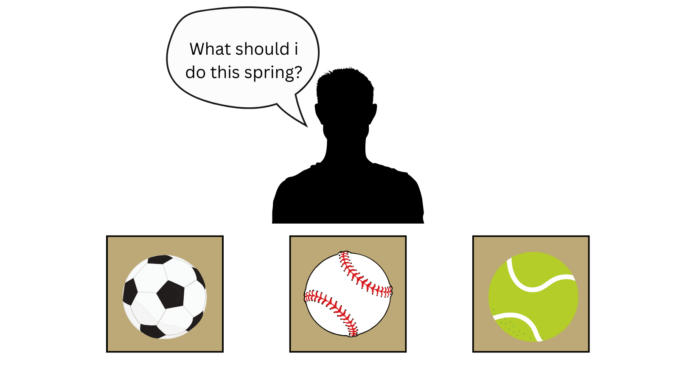
To play or not to play? It’s a decision parents and athletes face as sports swing from winter programs to the spring and summer seasons. Year-round play allows athletes to stay sharp and improve skills while continuing to play the sport they love, but is considerably time-consuming and comes at a high cost.
While parents enjoy seeing their kids participate in various sports during the spring, some may wish that their kids take a break from the long winter sports season.
In Fredericton, Tara Forster is the mother of two teen daughters who are both engaged in several sports activities, including a few in the spring.
Her oldest daughter, Gabby, is 14 years old and plays competitive hockey in the winter and recreational ringette in the spring. Gabby practices up to twice a week and has an organized game once a week with her ringette team.
“Every Sunday consists of going through all the various schedules for everything and writing it all in a calendar so everybody knows what’s going on,” Forster said.
Her youngest daughter, Allyson, is a 12 year-old and plays competitive ringette in the winter as well as in numerous school sports such as basketball, volleyball and cross-country.
“Every single one that exists, she does them all,” Forster chuckled.
She says the challenge of spring sports is balancing the variety of school sports Allyson competes in. Although Forster enjoys spending time with her kids, watching them grow and mature as she drives them to various sports, she admits that it can be a bit much.
“As exhausting as it is, it’s worth it.”
“I prefer a little bit of a break, even if it’s just a two-week break in the season,” Forster said.
Currently, the buildup for Provincials is taking place, but after the season, Forster suggested she’d like to see her kids recover.
“It’s an opportunity for them and their bodies to kind of recuperate a little bit,” she added.
Stacey Radke, a mother from Langdon, Alberta, has two teenage sons, Connor and Griffin, who both play high-level hockey. Connor, a 17-year-old, plays for the Kamloops Blazers in the Western Hockey League, while Griffin, 14 years old, plays double-A for the Wheatland Warriors.
The family’s entire winter months are dedicated to hockey.
Connor’s hockey continues into the spring season, where the schedule can run from August to June with training camp and possible playoffs.
Radke admits the cost of playing spring sports is a massive financial commitment.
“The spring season alone, I think we used to spend like $10,000 just for fees and everything else on top,” Radke said.
She adds that spring hockey tends to focus on travel tournaments and more ice time during the week, an additional financial commitment on top of the fees. There could be a tournament every two to three weeks, as opposed to two times a season in the winter.
“I would say it’s probably four days a week of skating where winter is maybe two,” she said.
The Radke family often travels across western Canada for hockey and has travelled as far away as Chicago.
“Did I love it? No. But [Connor] wouldn’t be where he is right now if he didn’t do spring and summer hockey,” Radke said of her oldest, who has dreams of playing in the NHL.
Griffin has chosen to play baseball in the spring and into the summer rather than focusing on hockey. But again, as much as Radke loves seeing her two boys enjoy spring sports, the financial burden of baseball is remarkably high.
“When you get to year-round, high-level baseball, it’s like $30,000 for the season,” Radke said.
Payton Jacobs, a member of the St. Thomas University Women’s Hockey team, uses spring hockey to enjoy a bit of time off, reflect on the past season and improve parts of her game even while working a summer job.
Before Jacobs played for STU, she played spring hockey on several separate teams in her hometown of Richmond, Ont., near Ottawa.
Similar to Radke’s sons, Jacobs participated in spring hockey tournaments with her teams back home. She regularly travelled within Ontario and, for a spring tournament in 2019, she went to Sweden and Finland.
When Jacobs returns home to Richmond for the late spring and into the summer, she works with Shelley Kettles, the Ottawa Senators’ technical skating specialist coach.
“We work on skating drills and then you incorporate a puck into it,” said Jacobs. “You’ll skate for maybe an hour and then for like, 15 minutes, you’ll do the same thing but with a puck.”
In the off-season, Jacobs stays fresh by playing games two times a week and regularly hits the gym to build strength, increase her lateral movements and work on plyometrics.
“I like playing hockey, but I definitely try to do a little bit less so that I can improve more off the ice to improve more on the ice,” Jacobs said.
“I play on a team of girls who are all from university when they come back. It’s more just to keep sharp.”
The current schedule for the Tommies women’s hockey team involves two weekly spring training sessions until the end of the academic year. The players then return to their hometowns to improve for the upcoming season.
It’s safe to say there are mixed reviews on spring sports from parents and athletes. The financial aspect of spring sports is certainly a massive weight on parents’ shoulders, but if they enjoy seeing their kids have fun and playing sports, the potential can be rewarding.
